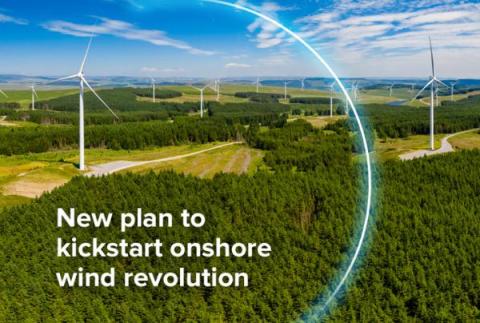New plan to kickstart onshore wind revolution
Onshore wind strategy published as part of mission to become a clean energy superpower.
The amount of clean, homegrown energy from onshore wind is set to accelerate over the second half of the decade as the government launches the first ever onshore wind strategy.
Thousands of new jobs for British people in onshore wind, such as engineering, construction, and operations maintenance, could be created by 2030 to build the onshore wind needed to deliver clean power for families and businesses.
After facing a de-facto 9-year ban in England, today’s strategy sets out over 40 radical actions to get onshore wind building again across the UK. This includes:
- unlocking up to 10 GW of onshore wind by resolving issues with how onshore wind turbines and aerospace civil and defence infrastructure co-exist
- repowering of old turbines across the country, so we can maintain our current fleet and keep powering the country with clean, secure, homegrown power
- equipping planners and developers with the tools needed for the first English projects since we lifted the de facto ban last year. This includes making sure planning decisions are based on up-to-date information and ensuring site surveying and assessments for projects are more efficient to speed up decision-making
- exploring plans to expand the clean industry bonus for onshore wind, encouraging developers to invest in supply chains in the UK’s industrial heartlands, or in cleaner supply chains
Today’s strategy bolsters the strong foundations the government has built since taking office to get the industry moving again, such as lifting the ban in England and reintroducing onshore wind into the Nationally Significant Infrastructure Projects regime. These measures mean that onshore wind will be put on an equal footing to offshore wind and nuclear, meaning projects can get built quicker in the years to come.
Delivering this strategy could more than double the current onshore wind workforce, supporting up to 45,000 skilled jobs across the country by 2030, as the government pursues its clean power ambition of 27-29 GW of onshore wind by 2030.
Clean energy is the economic opportunity of the twenty-first century, and thanks to the government’s clean energy mission, investment is booming in the UK, with over £40 billion of private investment in clean energy announced since July.
Onshore wind is one of the easiest and cheapest technologies to build and will supply British homes and businesses with clean, secure homegrown power that ends a reliance on unstable global gas markets – all part of the mission to get bills down for good.
Energy Minister Michael Shanks said: "Rolling out more onshore wind is a no-brainer – it’s one of our cheapest technologies, quick to build, supports thousands of skilled jobs and can provide clean energy directly to the communities hosting it. After years of decline, we’re giving industry the tools to get building again, backing industrial renewal and secure, clean, homegrown energy through our Plan for Change."
Matthieu Hue, co-chair of the Onshore Wind Taskforce and CEO of EDF Power Solutions UK and Ireland, said: "This strategy is focusing on overcoming barriers and challenges we face across the industry in the deployment of onshore wind while capturing the major socio-economic benefits it can bring to the environment and to local economies. Together we are forging a path forward for onshore wind in Great Britain, and we are committed to ensuring a successful implementation through a new Onshore Wind Council, which will oversee the execution of the strategy. This is a critical part of making Britain a clean energy superpower and delivering energy security."
Communities are set to benefit too with the voluntary community benefits guidance for onshore wind for England being updated to provide communities with £5,000 per megawatt per year for community initiatives, such as new football pitches or libraries, or even bill discount schemes.
By delivering the upper Clean Power 2030 ambition of 29 GW of onshore wind, it’s estimated that an additional £70 million of community funding will be unlocked for rural towns and villages every year.
Today’s measures come as the government has completed a process to de-risk offshore wind developments, led by the Marine Spatial Prioritisation Programme, thus unleashing the potential for offshore wind development in the English sea in the future.
This will help guide The Crown Estate’s Marine Delivery Routemap on strategic use of the seabed to unlock offshore wind in a way that considers all marine sectors including fisheries and protects the marine environment.
This should also reduce the planning consent risk for developers on future offshore wind sites before seabed rights are tendered – speeding up and de-risking future offshore wind projects.







